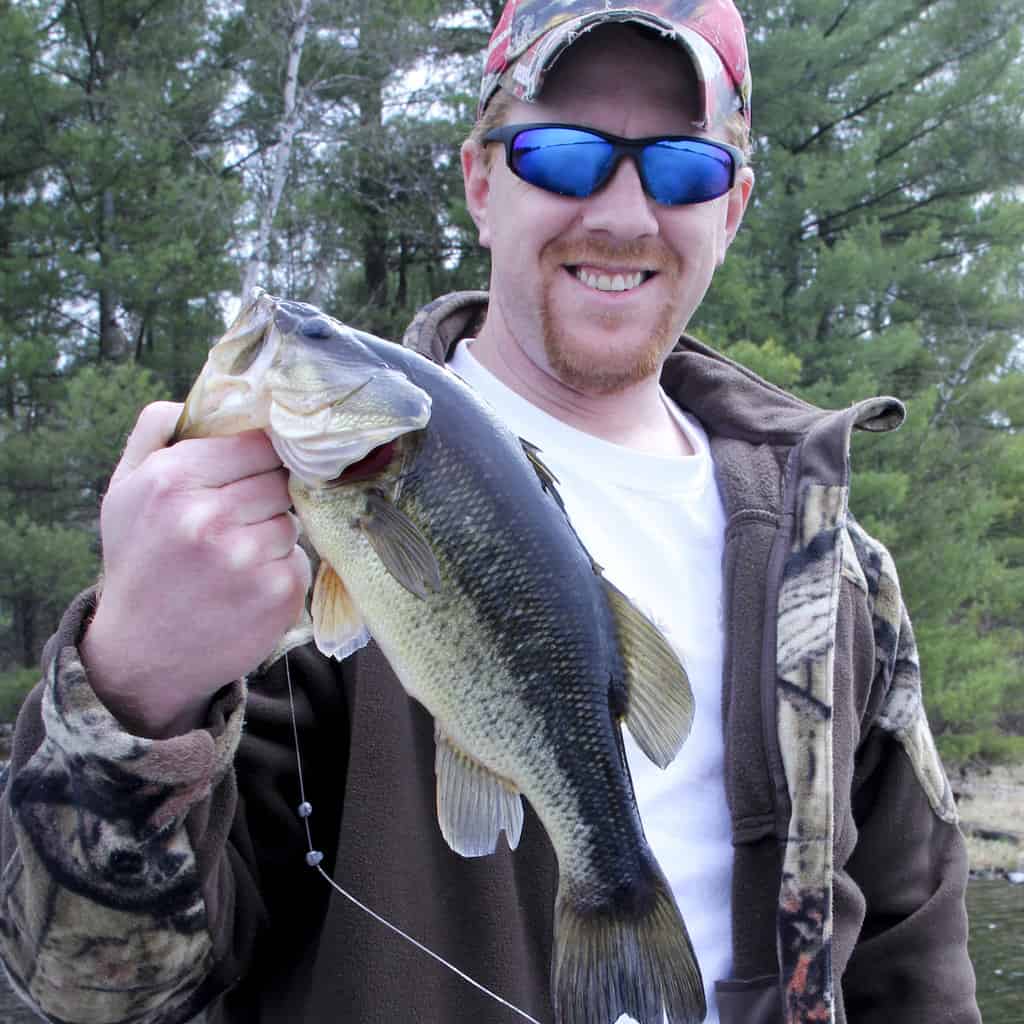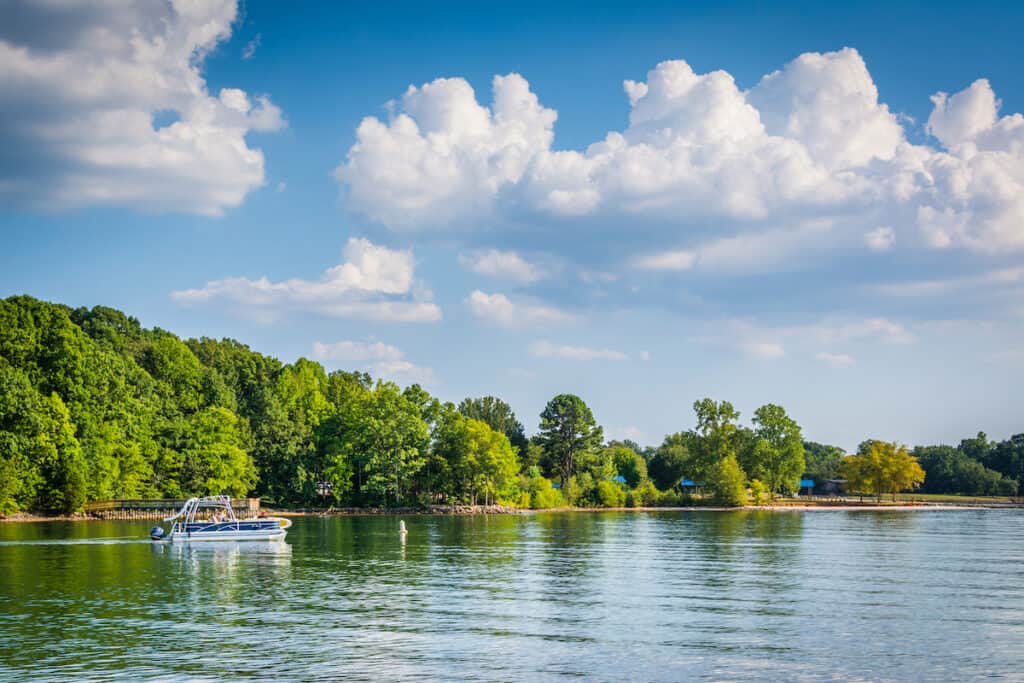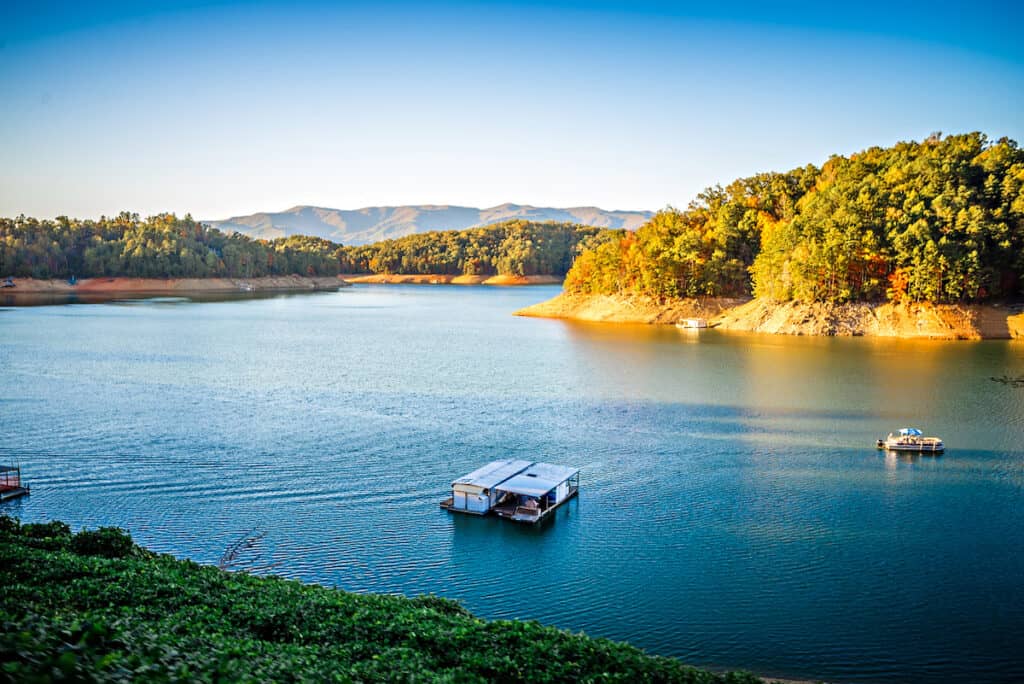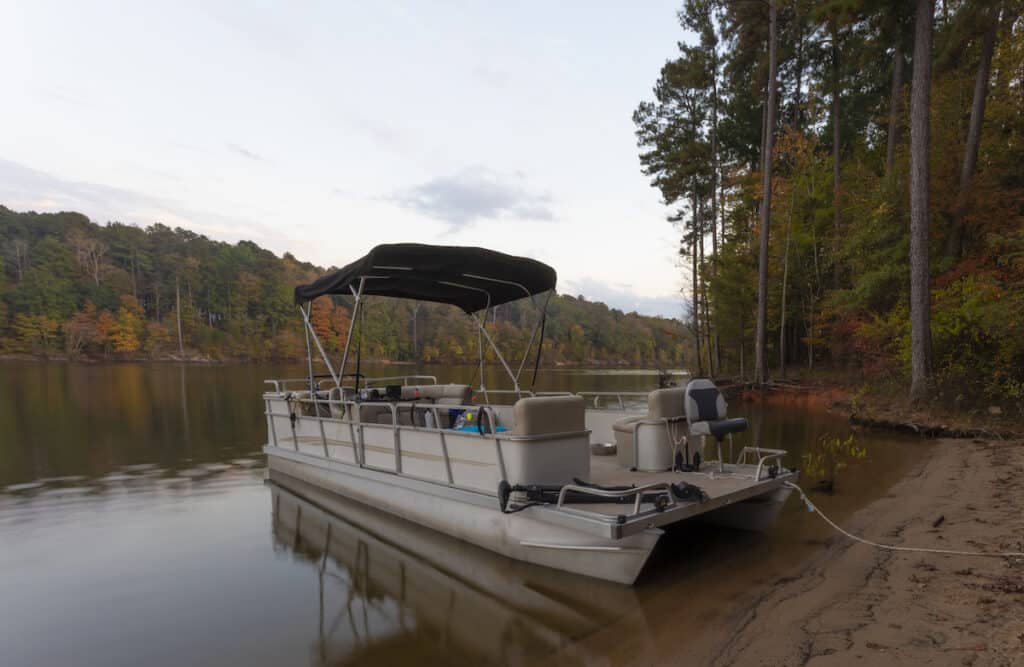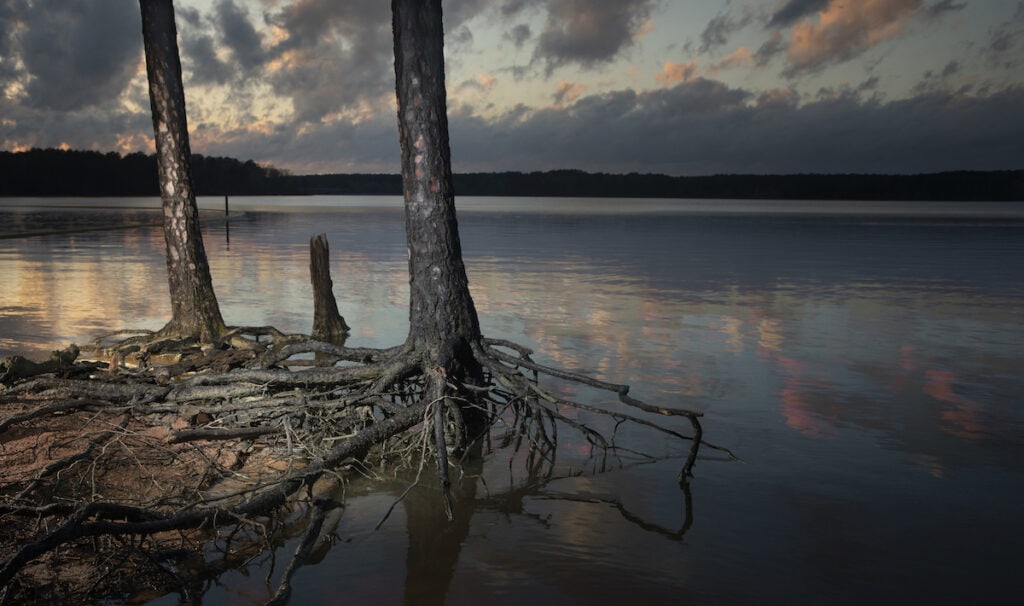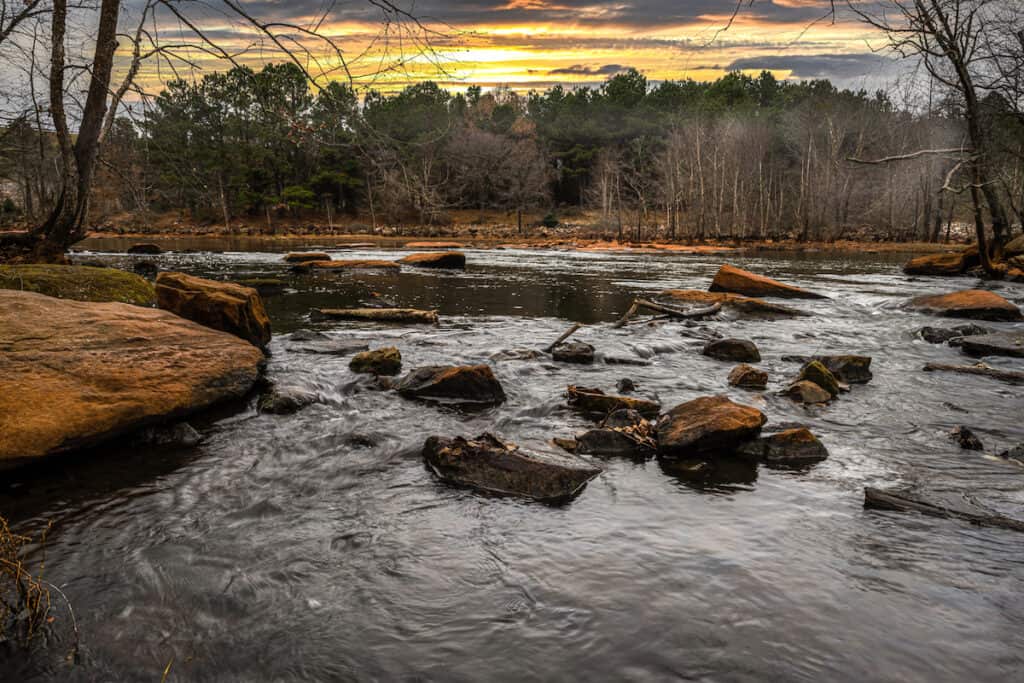Vast reservoirs, fertile farm ponds, tumbling mountain streams and broad tidal rivers—North Carolina offers bass anglers a lot of options.
North Carolina also provides some of the best bass fishing in the Southeast, with a genuine shot at largemouths over 10 pounds. Spotted bass and smallmouth bass are also on the docket in many waters.
Slot limits on some of North Carolina’s best bass lakes are designed to promote trophy bass fisheries, and ample stocking by the North Carolina Wildlife Resources Commission supplements naturally reproducing populations in many areas.
Spring tends to be the best time to fish for bass on North Carolina lakes and reservoirs, with most largemouths spawning in April. On rivers, the summer months typically provide the best fishing.
9 Best Bass Lakes in North Carolina
Kerr Lake (Buggs Island Lake)
More often referred to as Buggs Island Lake on the Virginia side of the state line, Kerr Lake is a sprawling impoundment on the Roanoke River that offers some of the best bass fishing in either state.
Abundant 3- and 4-pound largemouths provide anglers with plenty of entertainment on this 48,900-acre reservoir, and it’s not rare for an 8-pounder to turn up at tournament weigh-ins.
Kerr Lake (a.k.a. Kerr Reservoir) is massive but often relatively easy to pattern.
Water levels are a key consideration. Kerr Lake is prone to wild fluctuations, and it’s common to find water either 10 feet above or below full pool.
When the water is low, that’s a sure sign that you should fish deep structure, like ledges, points and humps.
But when the water is up, it draws bass into the forests of water willow and buckbrush that grow along the shoreline. Fishing inundated brush is a consistent pattern here whenever high water allows it.
Weedless soft plastics are the best options for working the brush at Kerr Lake. Spinnerbaits and buzzbaits are also good for fishing above and around the outer edges of the submerged brush.
This lake also has a lot of riprap and deep stump fields, which are often productive in summer.
Kerr Lake also has an abundance of shad, and any lure in a shad pattern is likely to catch the eye of a hungry largemouth.
Alabama spotted bass have also been introduced to Kerr Lake, and their increasing number is cause for concern. Alabama bass seem most at home on the main lake, whereas largemouths are more abundant in coves and creek arms.
The main section of Kerr Lake that lies in North Carolina is the Nutbush Creek Arm, which is so large that anglers could easily approach it as an entire lake unto itself. But thanks to a reciprocal agreement with Virginia, Carolina anglers may access the entire reservoir.
More: Complete Guide to Fishing at Kerr Lake (Buggs Island Lake)
Lake Norman
At 32,510 acres, Lake Norman is the largest reservoir entirely within North Carolina. It’s also one of the best multi-species fishing lakes in the state, with great opportunities for both largemouth bass and spotted bass.
Lake Norman is just a half-hour north of Charlotte, and this Catawba River impoundment offers 520 miles of shoreline notched with hundreds of finger-like creeks. As a general rule, the backs of those creeks are the best places to catch bass in spring and fall.
Dock fishing is big here. Norman’s shoreline is lined with innumerable boat docks. When bass are in the backs of creeks, the docks there are the structures they most often relate to.
That makes skipping soft plastics under docks a crucial skill for fishing this lake. Creature baits, soft stick baits and tube jigs are all great choices for dock fishing, with one of the key variables being whether bass favor deep docks or shallow docks on any given day.
Even in summer, when some bass retreat to deeper drop-offs and brush piles, many still seek shade beneath Lake Norman’s docks. If you like fishing in shallow water, this lake is for you.
In summer, largemouth bass feed heavily on bream, which bed down and spawn in succeeding waves from May well into summer. Bluegill-colored topwater poppers are likely to attract some major blow-ups.
Spotted bass, by contrast, are more comfortable in open water and commonly school up off main lake points and channels. They often suspend halfway down in 20 to 30 feet of water.
There’s a good case to be made that Lake Norman is North Carolina’s best “spot” lake. Most spotted bass here weigh 1 to 3 pounds, but a state record weighing 6 pounds, 5 ounces was caught here in 2003, and 4-pounders are reasonably common.
More: Complete Guide to Lake Norman Fishing
High Rock Lake
Built in 1929, High Rock Lake is a 15,180-acre reservoir on the Yadkin River, the northernmost of a string of reservoirs known as the Uwharrie Lakes. It’s a tournament staple and has hosted multiple Bassmaster Classics.
Recent bass population surveys by the NC Wildlife Resources Commission have found that largemouths are not only abundant but also span a wide size range. Bass measuring 15 to 18 inches were the most common size class, along with young-of-the-year bass that should ensure the quality fishery in future years.
Depending on the season, anglers have a lot of different avenues to pursue here. Shallow patterns are often best in spring, with the spawn usually peaking in early May.
And there’s a lot of great shallow habitat here. The area anglers might consider the main lake is relatively small, with the bulk of the reservoir within the Yadkin River Arm and several major creek arms.
Of the latter, the Second Creek and Abbotts Creek areas are often best. Fishing in the creek arms offers a lot of great shallow dock, brush and bream bed options, as well as deeper structure.
And as good as High Rock’s shallow spring bite can be, this lake is more widely known as a place where bass go deep. That’s especially true after the spawn when largemouths often school up on offshore humps, ridges and points.
Under those circumstances, a good-sized plastic worm on a Carolina rig is the go-to offering. The lake’s abundant deep structure also makes it a dream to fish for anyone whose go-to lure is a crankbait.
High Rock Lake is usually lightly stained and may have a bit of current, depending on whether the nearby power plant is drawing water. When they’re running water, it creates a current on the main lake that draws bass to offshore structure.
High Rock also is among the better places in North Carolina to catch striped bass.
Shearon Harris Reservoir
Often referred to simply as Harris Lake, Shearon Harris Reservoir spans 4,100 acres less than 30 minutes southwest of Raleigh.
Harris Lake has been called North Carolina’s best bass lake. While that crown tends to get passed around from year to year, that makes it no less prestigious in a state with so much incredible bass fishing.
Largemouths in Harris Lake are typically fat and healthy, with lots of 3- to 5-pounders waiting to be caught. As in many lakes, pre-spawn is the best time to catch a trophy.
On Harris Lake, finding grass is crucial in springtime. The lake has prolific beds of hydrilla and water primrose, and the first new growth of greenery in March will attract a lot of bass.
By May, the primrose will likely be so thick that you’ll have to fish its edges rather than right in it.
Some of the best areas are the backs of Buckhorn, Tomjack and White Oak creeks. The Cary Branch also has some very productive grass beds, and bass typically spawn here in waves starting around the first full moon in April.
The grass pattern is pretty consistent in spring and usually repeats itself in fall. Fishing thick vegetation can be tricky, but weedless jigs and soft plastics help.
Don’t sweat it when you get hung up; if you jiggle your lure loose from the grass, bass often snatch it on the drop.
In early summer, as bass recover from the spawn, they turn their attention to the schools of shad and white perch that provide ample forage on the main lake.
Points just outside of creeks like Little White Oak Creek and Skeet’s Gut are outstanding this time of year.
In summer, you often will find Harris Lake’s bass at 13 to 15 feet. Crankbaits, both lipped and lipless, can be excellent “search” lures.
Shearon Harris lacks a lot of traditional deep cover, so your electronics will also come in handy.
Fontana Lake
Tucked away in the Smoky Mountains at North Carolina’s westernmost corner, Fontana Lake is unique in more ways than one.
At 440 feet, it’s the deepest lake in North Carolina, and its cool mountain waters support one of the state’s only major walleye fisheries.
Smallmouth bass thrive in this clear, rocky lake for much the same reason walleye do, and Fontana has earned a reputation as North Carolina’s best smallmouth lake. Largemouth and spotted bass are also available, but smallies are the stars of the show.
A long, snakelike reservoir that encompasses 10,230 acres and stretches 29 miles end-to-end, Fontana Lake has numerous narrow coves and creek arms, with banks that are steep, rocky, and almost cliff-like in places.
The best time to catch smallmouths relatively shallow is springtime when they stage for the spawn on gravel bars and points. This is a great time to fish a jig or Ned rig in shallow water.
By summer, most smallmouths will have retreated to deeper habitats, though a few may still be found shallow in the early morning, along with the lake’s few largemouths. Try a topwater at sunrise.
In summer, it’s common to find a mix of smallmouths and spotted bass feeding on shad high in the water column over deep water.
Trolling shad imitations is the go-to search tactic, but casting a Shad Rap or blade bait can be more fun when the bite gets going.
There are also times in summer and fall when smallmouths will be 50 feet down or more, and deep trolling and jigging along the steep rocky bluffs is the best way to find them.
The lake is drawn down significantly in winter.
Many of Fontana Lake’s coves can be productive, but there’s usually great fishing right on the main Little Tennessee River channel. You can run into bass anywhere from Fontana Dam all the way up to the River Shoals.
The cool waters of Fontana Lake also make it one of North Carolina’s best trout fishing lakes.
Lake Phelps
One of North Carolina’s largest natural lakes, Lake Phelps spans 16,000 acres on the Albemarle-Pamlico Peninsula in the eastern part of the state. It’s an excellent, under-the-radar largemouth lake.
Lake Phelps has produced largemouths over 10 pounds, and 4-pound fish are common. Anglers often have to adjust their approach on this lake, which is quite different from the deep, sprawling reservoirs that provide most of North Carolina’s best bass fishing.
For one thing, Lake Phelps is close to a perfect oval in shape. For another, despite its vast size, the lake is little more than 7 feet deep at its deepest point.
That makes it a great place to fish from a kayak or a float tube, and it’s a prime bank fishing lake. Wade fishing is also very popular here, and Lake Phelps offers miles of open shoreline that are easy to wade.
That being said, this is cottonmouth country, so enter the water with caution.
Cypress forest borders much of the shoreline, providing exceptional shallow cover that allows largemouths to spawn prolifically. In spring, try a creature bait like a Brush Hog or Rage Bug among the cypress knees.
In late spring and early summer, there’s usually a phenomenal topwater bite on Phelps Lake. Try a Zara Spook or similar topwater lure over the lake’s grass beds.
Fly fishing for bass is also popular here, with lots of largemouths falling for streamers and poppers.
Phelps is also a great bream lake, and ample populations of bluegill and pumpkinseed sunfish provide food for hungry bass as well as quality angling opportunities in their own right.
Soft plastics in a bream-like color tend to do well.
Falls of the Neuse Lake (Falls Lake)
Commonly referred to as Falls Lake, 12,410-acre Falls of the Neuse Lake is an impoundment on the Neuse River at the northern edge of the Raleigh-Durham area.
Its location and the quality of its bass fishing make it a popular place to fish.
NC Wildlife surveys regularly turn up trophy-size bass and reveal a well-rounded population in all size classes.
Falls of the Neuse is about as close as you’ll get to a picture-perfect bass lake.
There’s a bit of everything here. The reservoir has a deep, clear main body with lots of sloping points and rocky ledges. Its shallow upper end is loaded with stumps and weed beds.
In between, you’ll find numerous creek arms with vast stump fields, well-defined creek channels, ample vegetation, occasional rocky outcroppings, and banks lined with laydown trees.
These structures are some of the best places to fish in April when bass are in various stages of pre-spawn and spawn.
Lodge, Lick, New Light and Upper and Lower Barton are some of the best creeks, but almost any of them can yield trophy bass in springtime.
Sight-fishing is often possible in the clear lower end of Falls Lake, with finesse plastics drawing strikes among laydowns and stumps.
In May and June, look for the biggest bass to move toward offshore ledges and other relatively deep structure to dine on shad. Focus your efforts on areas right along the main river channel, and have crankbaits, spinnerbaits and Carolina-rigged worms at the ready.
The upper end of Falls Lake can also be very productive in spring and fall, but use caution. Above the Highway 50 bridge, the lake is a minefield of stump-filled shallow flats that can yield 8-pound largemouths and also wreck your lower unit.
Roanoke Rapids Lake
It might not be fair to call Roanoke Rapids Lake “underrated.” After all, the annual striped bass run at Roanoke Rapids is the stuff of legends, bringing scores of anglers here every year. But it’s certainly underrated when it comes to largemouths.
Roanoke Rapids Lake is a 4,600-acre reservoir on the Roanoke River.
Roanoke Rapids is immediately downriver from Lake Gaston, which itself is just downriver from Kerr Lake. Understandably, its more famous neighbors draw more attention.
But that might be changing. Word is starting to get around that it often takes 23 pounds or more to win a bass tournament here, and Bassmaster ranked Roanoke Rapids among the best bass lakes in the Southeast in both 2022 and 2023.
In spring, the entire lake is in play. The shoreline is mostly undeveloped and there are relatively few major creeks on Roanoke Rapids Lake, leaving anglers to probe stump-filled flats and creek channel edges.
The best fishing takes place in summer when bass congregate at the upper end of the lake. Fueled by cool, oxygen-rich water discharges from the Gaston Dam, the upper end of Roanoke Rapids Lake is a summer bass powerhouse.
The key is to find edges. The upper end of the lake experiences an explosion of hydrilla, and the grass typically grows thick right out to the channel edge, which is itself lined with stumps in many places.
Fish the edges with a Fluke or a Senko, but use caution. The 18-foot river channel often abuts stumpy flats that are just 3 feet deep, and even a minor water level fluctuation can create a serious boating hazard.
Jordan Lake
When one reads about Jordan Lake these days, it’s usually in the context of how great the lake used to be. In the mid-1980s, when this 13,940-acre Piedmont Reservoir was fairly new, it was arguably the best bass lake in the state.
All these years later, Jordan Lake has had its ups and downs. However, it’s still more than capable of kicking out great numbers of bass and producing trophies, like the 11.85-pound largemouth that made headlines here in 2018.
Fed by the Haw and New Hope rivers, Jordan Lake offers 200 miles of shoreline and a wide range of deep and shallow cover. That includes ample beds of willow grass along the banks that draw bass in all seasons, especially in springtime.
Spring patterns depend on rain, which can bring the lake up and kick off an epic shallow bite around flooded points and shorelines, many of which are lined with rocks and stumps. With high water, look for fat pre-spawn largemouths close to the bank in March.
Early to mid-April is usually the peak of the spawn, after which bass can go in a lot of directions. Many stay shallow and dine on bream, which typically go into their own spawning season just as bass are finishing theirs.
Many bass will head toward the main lake structure in summer, but “deep” on Jordan Lake seldom means more than 15 to 20 feet. And once a thermocline sets up, usually around 10 feet, it restricts bass to the upper part of the water column.
Artificial structures like old flooded road beds, bridges and foundations also provide a lot of great fishing on Jordan Lake. One particular roadbed, which stretches from just east of the New Hope Overlook boat launch to Vista Point, is especially legendary.
Speaking of legendary, Jordan Lake is easily among the best crappie fishing lakes in North Carolina.
6 Best Bass Rivers in North Carolina
French Broad River
Easily one of North Carolina’s best smallmouth rivers, the French Broad River originates in Transylvania County before flowing northwestward through Asheville and, eventually, across the Tennessee state line. Roughly 117 of the river’s 213 miles flow through North Carolina.
The French Broad is one of America’s oldest rivers. Over many millennia, it has cut a course through the Appalachian Mountains, exposing tiers of layered bedrock that form diagonal ledges and shelves across the riverbank.
These ledges provide spectacular smallmouth habitat, and in areas where the river is shallow enough to wade, anglers often walk across the rocky ledges and fish into the deep water below.
The Hot Springs area near the state line offers a lot of great wade fishing.
It’s common for bass anglers to also catch rainbow trout, which are regularly stocked in this area. Smallmouths are more common, however, and they willingly strike spinners, spoons and various soft plastics.
Fly fishing for smallmouths is also an option. Crawfish and hellgrammite imitations are great, along with classic streamers like Clouser Minnows. Terrestrials also tempt a lot of smallies in summer.
Certain stretches of the French Broad River have some fairly challenging whitewater, while other areas are well-suited to float fishing and kayaking.
The Asheville area is generally fairly tranquil, and numerous access points in and around the city are conducive to kayaking.
Summer and early fall offer the lowest flows and easiest fishing conditions, and it’s not unusual to catch 50-plus smallmouths in a day. Most measure 10 to 14 inches, but 20-inch fish are not unusual.
In addition to the French Broad River’s prominent ledges, look for smallmouths around any structure that creates a seam or provides a break in the current. Boulders, gravel bars, fallen trees and bridge pilings are all good targets.
Chowan River
Some of the best largemouth bass fishing in North Carolina can be found in its coastal rivers, and the Chowan River commonly ranks among the best of the best.
The Chowan River commonly hosts bass tournaments, and participants regularly weigh in 7-pound largemouths.
The Chowan River begins in the southeast corner of Virginia with the convergence of the Blackwater and Nuttaway rivers. It offers about 50 miles of prime bass fishing in North Carolina before emptying into Albemarle Sound.
A broad, slow-rolling river, the Chowan is around 300 yards across as it enters the state, but balloons to two miles by the time it reaches the sound. Only slightly brackish at its mouth, the entire river can and does support abundant largemouths.
Log jams and other cover litter the main channel, creating excellent summer habitat. Jungle-like cypress swamps line virtually the entire river to offer outstanding bass habitat and spawning grounds.
Casting a crankbait around the cypress trees is a tried-and-true method for tempting big bass on the Chowan. Buzzbaits also have their devotees here, and it’s always a good idea to have one handy.
Of course, a dark-colored plastic worm on a Texas or Carolina rig will also do the job. The Chowan River tends to be lightly tannin-stained but usually isn’t too muddy, except after a rain.
Some of the best fishing is on smaller creeks that feed the Chowan River, like Salmon Creek and Rocky Hock Creek. Creeks also offer shelter from the wind, which can easily churn up the main river.
The Holiday Island area is also excellent, with boat ramps and a fishing pier at Cannons Ferry.
New River
The New River is one of the most legendary smallmouth Rivers in America. But when most folks talk about New River smallmouth fishing, they’re usually talking about the section several hundred miles north in West Virginia.
But the New River’s headwaters lie in the mountainous northwest corner of North Carolina. The North and South Forks of the New River meet to form its main stem, which then crisscrosses the Virginia line. (The New is also among the top bass fishing rivers in Virginia.)
A reciprocal agreement allows anglers from either state to fish the New River from the meeting of its forks to the confluence of the Little River, and this whole stretch offers exceptional bass fishing.
Some smallmouths weigh 4 to 6 pounds, though 1- and 2-pounders are more typical.
The best time to fish North Carolina’s New River is summer. Most years, the river is low enough to float safely or wade by June, and it mostly stays that way through September unless a major storm hits.
It’s worth noting that the New River has some steep ledges and drop-offs, which, while providing prime smallmouth habitat, can pose a danger to anyone wading out into the river.
Soft plastics like tubes, grubs and finesse worms are ideal lure choices on medium-light tackle. Top colors include green pumpkin when the water is clear and junebug when it’s a little stained. Cast around ledges, rocky outcroppings, and any other structure that creates a current seam.
Fly fishing is also a great option here, and anglers do well with terrestrials and poppers during the summer months.
If you’re floating the river, try casting your fly toward the banks, where smallmouths often wait for insects to fall from the shoreline trees.
In addition to the main stem of the New River, both of its forks offer equally excellent smallmouth fishing.
North Carolina’s New River State Park consists of multiple units that offer access to various sections.
Cape Fear River
Flowing into the Atlantic Ocean after a 191-mile traverse across east-central North Carolina, the Cafe Fear River is a blackwater river that supports ample populations of both largemouth and spotted bass.
The latter have become more common in recent years, but the Cape Fear still produces a lot of bucketmouths, which average about 2 pounds here but are capable of surpassing 8 pounds.
There’s excellent bass fishing in tidal and non-tidal portions of the Cape Fear River alike.
Starting in the tidal portion, the grassy marsh banks alongside the river just above Wilmington produce some great bass action, and major tributaries like Northeast Cape Fear River and the Black River are also excellent.
Falling tides are usually the best times to fish the tidal Cape Fear. Ebb tides draw bait fish out of the creeks to offer a potential buffet to hungry bass. Creeks like Turnbull, Hammonds, Sturgeon and Livingston can also be great after a rain.
Farther up above the tidal portion of the river, the Cape Fear is generally slow and plodding, and there’s great spring pre-spawn and spawn fishing when conditions allow. The stretch of river above Buckhorn Dam is one of the best.
Look for pre-spawn largemouths in tributaries like Bush, Lick and Yarborough creeks just off the upper Cape Fear River in April. They’ll be around the mouths of the creeks at this time, and spawning usually takes place a few weeks later at the backs of the creeks.
Laydowns along the banks are prime targets for spring and summer largemouths on the upper Cape Fear.
The upper river is also where spotted bass are most common, especially from Buckhorn Dam down through Raven Rock State Park.
Little Tennessee River
Another exceptional smallmouth stream in Western North Carolina, the Little Tennessee River begins in Georgia before swinging through the Tarheel State on its way to Tennessee.
This is a beautiful stream to fish, meandering its way through rolling mountains.
The Little Tennessee River flows through Franklin, NC, where it is dammed to form 83-acre Lake Emory. There’s some great fishing above Franklin, with smallmouths mixed with the occasional trout, but the best fishing is below it.
From the lower end of Lake Emory, the “Little T” offers 25 miles of free-flowing smallmouth water down to the point where it passes under US-74 and feeds the upper end of Fontana Lake.
This section contains pools, ledges, eddies, pocket water, and all sorts of prime smallmouth structure.
It’s also fairly easy to walk, wade or float most of the river, with the exception of the area known as The Narrows right above Fontana Lake, which has some challenging rapids.
Local guides typically beach their canoes or float tubes at likely-looking spots and set out on foot to reach secluded smallie holes.
When the river is low in summer, the fishing is outstanding.
There’s also a feeding frenzy in October as bass get ready for winter.
Small crankbaits, buzzbaits and a variety of soft plastics all produce on spinning gear, and fly anglers usually do well with Clouser Minnows, Wooly Buggers, crawfish flies and Wiggle Minnows. Poppers are great in late summer.
Needmore Road runs alongside a long stretch of the Little Tennessee River and provides access to multiple kayak launches and bank fishing sites.
It’s not unusual to catch and release over 50 smallmouths in a day, with occasional giants up to 4 pounds.
Neuse River
Originating in the Piedmont region and emptying into Pamlico Sound below New Bern after a 275-mile journey, the Neuse River is the longest river contained entirely within North Carolina.
It’s also one of the state’s great largemouth bass rivers.
There’s excellent fishing for largemouths (as well as resident striped bass) in the broad, brackish lower section of the river below New Bern, and especially in tidal creeks like Core Creek and Adams Creek.
In the tidal Neuse and its tributaries, falling tides often produce the best bass fishing, with low water turning on the bite and making the fish more accessible. Running a buzzbait around shallow cover when the river is at 5 feet and falling is a good bet.
Low water also makes summer the best time to fish the river. When the Neuse is down, the deepest holes will be loaded with bass.
But great fishing here isn’t restricted to tidal portions of the river. The Neuse River can be excellent all the way up to the Raleigh area, where it is dammed to form Falls of the Neuse Reservoir (Falls Lake) mentioned above.
Like the tidal portion, the best fishing on the upper Neuse is in summer. When spring rains have subsided and dam releases are over, the river is often shallow enough to walk across in places. Look for bass around cypress trees, fallen logs and along steep banks.
Fly fishing for largemouths is a unique pastime on the Neuse and its tributaries like Pitch Kettle and Contentnea creeks.
Summer is topwater season, with poppers often attracting big bream as well as bass up to 5 pounds.
The Neuse River also has excellent fishing for catfish.
Catch More Bass
Check out our full bass fishing guide that breaks down the best techniques, lures and other tips.

